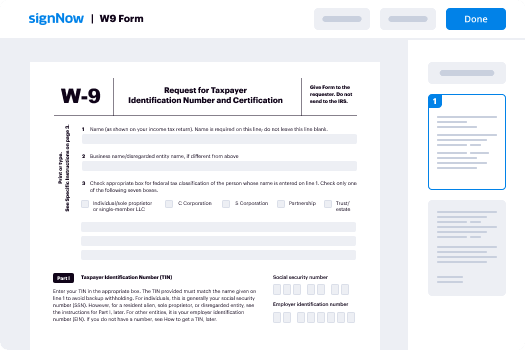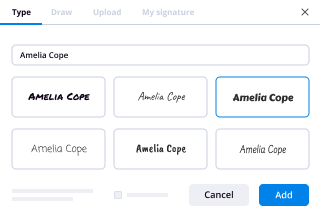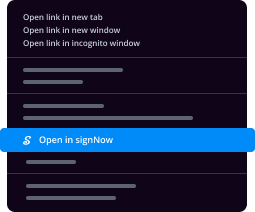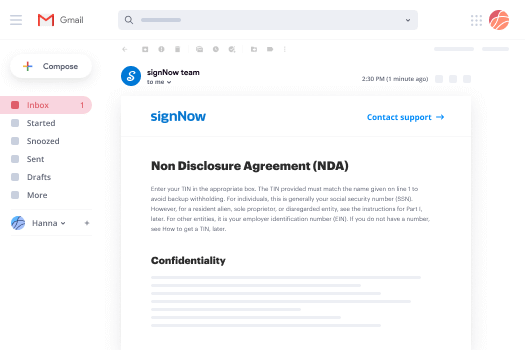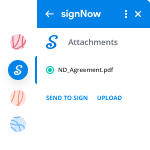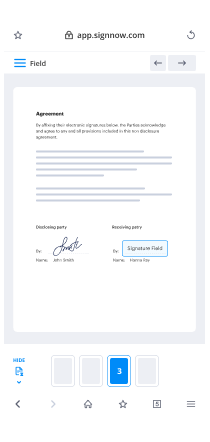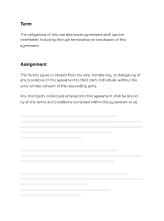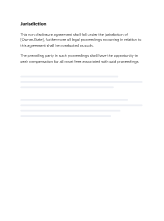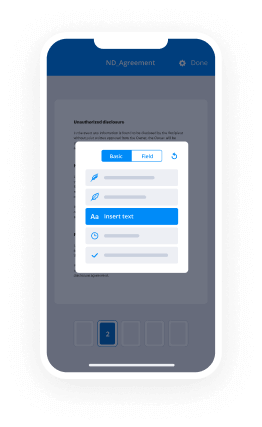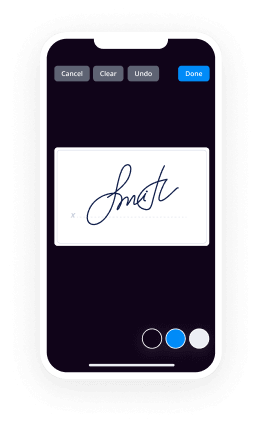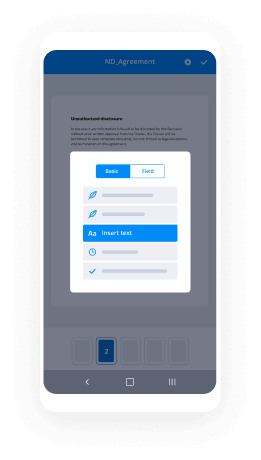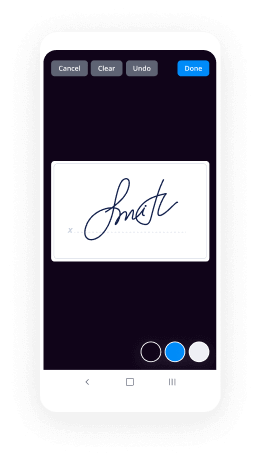Firma Electrónica vs. Firma Escrita
- Rápido para iniciar
- Fácil de usar
- Soporte 24/7
Las empresas con visión de futuro de todo el mundo confían en SignNow






Guía rápida sobre cómo usar la función electronic handwritten signature
¿Está su organización lista para reducir ineficiencias en tres cuartas partes o más? Con airSlate SignNow eSignature, semanas de negociación de contratos se convierten en días, y horas de recolección de firmas se convierten en minutos. No necesitará aprender todo desde cero gracias a la interfaz clara y las guías fáciles de seguir.
Complete los siguientes pasos que se enumeran a continuación para usar la funcionalidad will digital signatures replace handwritten ones en unos pocos minutos:
- Inicie su navegador web y visite signnow.com.
- Regístrese para una prueba gratuita o inicie sesión con su correo electrónico o credenciales de Google/Facebook.
- Haga clic en Avatar de Usuario -> Mi Cuenta en la parte superior derecha de la página.
- Personalice su Perfil de Usuario con sus datos personales y ajuste la configuración.
- Diseñe y gestione su(s) Firma(s) Predeterminada(s).
- Regrese a la página del panel de control.
- Desplace el cursor sobre el botón Cargar y Crear y elija la opción necesaria.
- Haga clic en la tecla Preparar y Enviar junto al nombre del documento.
- Escriba la dirección de correo electrónico y el nombre de todos los firmantes en el cuadro emergente que se abre.
- Utilice la opción Comenzar a agregar campos para comenzar a modificar el documento y firmarlo usted mismo.
- Haga clic en GUARDAR Y INVITAR cuando haya terminado.
- Continúe ajustando su flujo de trabajo de eSignature utilizando más funciones.
No puede ser más fácil usar la función will digital signatures replace handwritten. También está disponible en sus dispositivos móviles. Instale la aplicación airSlate SignNow para iOS o Android y gestione sus flujos de trabajo de eSignature personalizados incluso mientras está en movimiento. Olvídese de imprimir y escanear, de archivar laboriosamente y de la costosa entrega de documentos.
Cómo funciona
Califica tu experiencia
What is the electronic signature vs handwritten
An electronic signature is a digital representation of a person's intent to agree to the contents of a document. It can take various forms, such as a typed name, a scanned image of a handwritten signature, or a unique digital code. In contrast, a handwritten signature is the traditional method where an individual physically signs their name on paper. While both types serve the same purpose of indicating consent or agreement, electronic signatures offer greater convenience and efficiency in a digital environment.
How to use the electronic signature vs handwritten
To use an electronic signature, individuals can utilize platforms like airSlate SignNow to upload documents that require signing. Users can fill out necessary fields, add their electronic signature, and send the document for signature to others. This process is typically completed within minutes, compared to the time-consuming nature of handwritten signatures, which require printing, signing, and scanning or mailing documents. The electronic method streamlines workflows, allowing for faster transactions and reduced paper usage.
Legal use of the electronic signature vs handwritten
In the United States, electronic signatures are legally recognized under the Electronic Signatures in Global and National Commerce (ESIGN) Act and the Uniform Electronic Transactions Act (UETA). These laws establish that electronic signatures hold the same legal weight as handwritten signatures, provided that both parties consent to use electronic means for signing. This legal framework supports the use of electronic signatures in various scenarios, including contracts, agreements, and forms, ensuring that they are valid and enforceable.
Steps to complete the electronic signature vs handwritten
Completing an electronic signature involves several straightforward steps:
- Upload the document to the airSlate SignNow platform.
- Fill in any required fields, such as names and dates.
- Add your electronic signature by selecting a signature type or drawing one.
- Send the document for signature to the intended recipients.
- Once all parties have signed, securely store or share the completed document.
This process eliminates the need for printing and mailing, making it a more efficient choice compared to handwritten signatures.
Security & Compliance Guidelines
When using electronic signatures, it is essential to adhere to security and compliance guidelines to protect sensitive information. Platforms like airSlate SignNow implement encryption and authentication measures to ensure that signatures are secure and tamper-proof. Users should also verify the identity of signers through methods such as two-factor authentication or secure access codes. Compliance with legal standards, such as the ESIGN Act, ensures that electronic signatures are valid and recognized in legal contexts.
Examples of using the electronic signature vs handwritten
Electronic signatures are commonly used in various industries and scenarios, including:
- Real estate transactions, where contracts and agreements can be signed digitally.
- Human resources, for onboarding documents and employment contracts.
- Financial services, for loan agreements and account openings.
- Healthcare, for patient consent forms and medical records.
These examples illustrate how electronic signatures can enhance efficiency and streamline processes across different sectors, making them a preferred choice over handwritten signatures.
¡Obtenga ahora firmas vinculantes desde el punto de vista jurídico!
-
Mejor ROI. Nuestros clientes logran un promedio de 7x ROI en los primeros seis meses.
-
Se adapta a sus casos de uso. De las PYMES al mercado medio, airSlate SignNow ofrece resultados para empresas de todos los tamaños.
-
Interfaz de usuario intuitiva y API. Firma y envía documentos desde tus aplicaciones en minutos.
Firma en línea FAQs
-
Will digital signatures replace handwritten ones in legal documents?
Yes, digital signatures are legally recognized in many jurisdictions and can replace handwritten signatures in legal documents. They provide a secure and efficient way to sign contracts, making them a viable alternative. As more businesses adopt digital solutions, the trend suggests that digital signatures will increasingly replace handwritten ones. -
What are the benefits of using digital signatures over handwritten ones?
Digital signatures offer numerous benefits, including enhanced security, faster turnaround times, and reduced paper usage. They streamline the signing process, allowing for quicker transactions and improved workflow. As businesses seek efficiency, the question of whether digital signatures will replace handwritten ones becomes more relevant. -
How does airSlate SignNow ensure the security of digital signatures?
airSlate SignNow employs advanced encryption and authentication methods to ensure the security of digital signatures. This protects sensitive information and verifies the identity of signers. With these robust security measures, businesses can confidently transition from handwritten signatures to digital ones. -
Are digital signatures more cost-effective than handwritten ones?
Yes, using digital signatures can be more cost-effective than handwritten ones. By reducing the need for paper, printing, and postage, businesses can save money over time. As companies evaluate their expenses, the question of whether digital signatures will replace handwritten ones becomes increasingly pertinent. -
Can airSlate SignNow integrate with other software for digital signatures?
Absolutely! airSlate SignNow offers integrations with various software applications, enhancing its functionality. This allows businesses to seamlessly incorporate digital signatures into their existing workflows, further supporting the idea that digital signatures will replace handwritten ones in many processes. -
What features does airSlate SignNow offer for digital signatures?
airSlate SignNow provides a range of features for digital signatures, including customizable templates, real-time tracking, and automated reminders. These tools simplify the signing process and improve user experience. As these features become more prevalent, the likelihood that digital signatures will replace handwritten ones increases. -
Is it easy to transition from handwritten signatures to digital signatures?
Yes, transitioning from handwritten signatures to digital signatures is straightforward with airSlate SignNow. The platform is designed to be user-friendly, making it easy for businesses to adopt digital signing practices. As more organizations make this shift, the question of whether digital signatures will replace handwritten ones becomes a reality.
Tu guía completa de cómo hacerlo
Solución confiable de eSignature
Únase a más de 28 millones de usuarios de airSlate SignNow
Obtener más
- Comienza con eSignature: firma documentos en android ...
- Comienza tu viaje de eSignature: firmar docx en línea
- Comience su viaje de firma electrónica: firmar pdf ...
- Aumenta el cumplimiento con eSignatures: firma un ...
- Comienza tu viaje de firma electrónica: firmar pdf en ...
- Comienza con eSignature: firmar pdf en iphone gratis
- Aumente el cumplimiento con eSignatures: firmó un ...
- Aumenta la Cumplimiento con eSignatures: acuerdo de ...




















